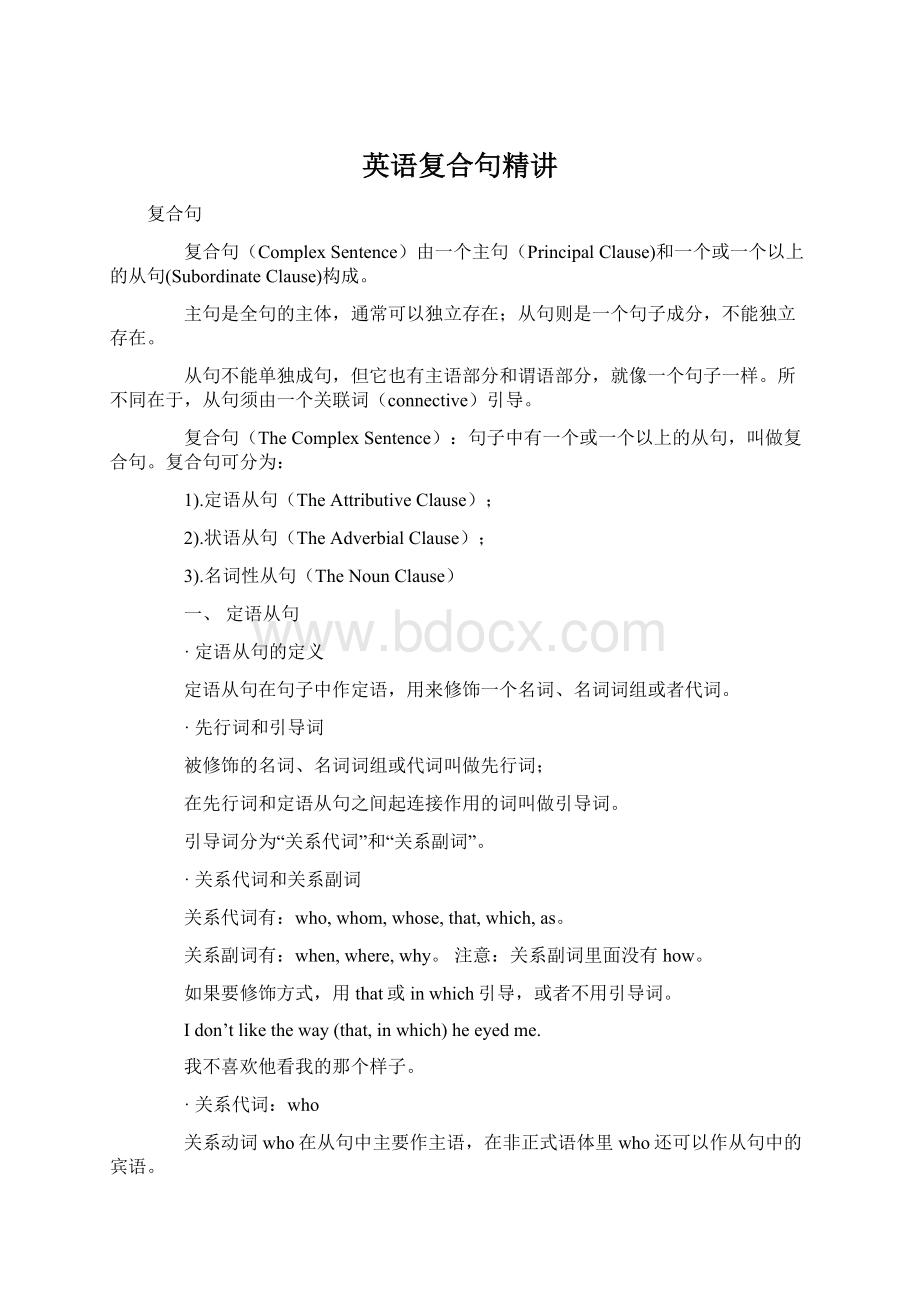英语复合句精讲.docx
《英语复合句精讲.docx》由会员分享,可在线阅读,更多相关《英语复合句精讲.docx(32页珍藏版)》请在冰豆网上搜索。

英语复合句精讲
复合句
复合句(ComplexSentence)由一个主句(PrincipalClause)和一个或一个以上的从句(SubordinateClause)构成。
主句是全句的主体,通常可以独立存在;从句则是一个句子成分,不能独立存在。
从句不能单独成句,但它也有主语部分和谓语部分,就像一个句子一样。
所不同在于,从句须由一个关联词(connective)引导。
复合句(TheComplexSentence):
句子中有一个或一个以上的从句,叫做复合句。
复合句可分为:
1).定语从句(TheAttributiveClause);
2).状语从句(TheAdverbialClause);
3).名词性从句(TheNounClause)
一、定语从句
·定语从句的定义
定语从句在句子中作定语,用来修饰一个名词、名词词组或者代词。
·先行词和引导词
被修饰的名词、名词词组或代词叫做先行词;
在先行词和定语从句之间起连接作用的词叫做引导词。
引导词分为“关系代词”和“关系副词”。
·关系代词和关系副词
关系代词有:
who,whom,whose,that,which,as。
关系副词有:
when,where,why。
注意:
关系副词里面没有how。
如果要修饰方式,用that或inwhich引导,或者不用引导词。
Idon’tliketheway(that,inwhich)heeyedme.
我不喜欢他看我的那个样子。
·关系代词:
who
关系动词who在从句中主要作主语,在非正式语体里who还可以作从句中的宾语。
Heisthemanwhowantstoseeyou.
HeisthemanwhoIsawintheparkyesterday.
·关系代词:
whom
Heistheman(whom)Isawintheparkyesterday.
(whom在从句中作宾语)
·关系代词:
whose
whose用来指人或物,(只能用作定语,若指物,它还可以同ofwhich互换)。
Theyrushedovertohelpthemanwhosecarhadbrokendown.
Pleasepassmethebookwhosecoverisgreen.(ofwhichthecover/thecoverofwhich)
·关系代词:
which
(1)
which指物,在从句中作主语或宾语,作宾语时在非正式语体中可以省略。
Theyneededaplantwhichdidn'tneedasmuchwaterasrice.
Thefarm(which)wevisitedyesterdayislocatedinthesuburbofBeijing.
·关系代词:
which
(2)
当在which和that面前进行选择的情况下,一般情况下要选which:
1.在非限制性定语从句中通常用which作引导词,而不能用that做非限制性定语从句的引导词。
2.修饰整个主句。
InevermetJuliaagainafterthat,whichwasapity.
3.修饰谓语部分。
Hecanswimintheriver,whichIcannot.
4.介词+which
Theyareallquestionstowhichtherearenoanswers.
·关系代词:
that
(1)
that多用来指物,有时也可以用来指人;在从句中作主语或宾语。
指物的时候多用that,也可用which。
It’saquestionthat(which)needscarefulconsideration.
(指物,作主语。
)
Whoisthemanthatisreadingamagazineunderthetree?
(指人,作主语。
)
Thegirl(that)wesawyesterdayisTom’ssister.
(指人,作宾语,可省略。
)
·关系代词:
that
(2)
在以下的情况中,只能用that作引导词,而不能用which作引导词。
1.先行词为all,everything,anything,nothing,little等不定代词时。
All(that)shelackedwastraining.
2.先行词被形容词最高级修饰时
ThisisthebestfilmthatIhaveeverseen.
3.先行词被序数词和thelast修饰时
4.先行词中既有人又有物时
Theytalkedabouttheteachersandtheschoolsthattheyhadvisited.
5.主句是含有who或which的特殊疑问句,为了避免重复时
二、状语从句
1地点状语从句
地点状语从句通常由where,whenever引导。
WhereIlivethereareplentyoftrees.
WhereverIamIwillbethinkingofyou.
2方式状语从句
方式状语从句通常由as,(just)as…so…,asif,asthough引导。
1)as,(just)as…so…引导的方式状语从句通常位于主句后,但在(just)as…so…结构中位于句首,这时as从句带有比喻的含义,意思是"正如…","就像",多用于正式文体,例如:
Alwaysdototheothersasyouwouldbedoneby.
你希望人家怎样待你,你就要怎样待人。
Aswateristofish,soairistoman.
我们离不开空气,犹如鱼儿离不开水。
Justaswesweepourrooms,soweshouldsweepbackwardideasfromourminds.
正如打扫房屋一样,我们也要扫除我们头脑中落后的东西。
2)asif,asthough
两者的意义和用法相同,引出的状语从句谓语多用虚拟语气,表示与事实相反,有时也用陈述语气,表示所说情况是事实或实现的可能性较大。
汉译常作"仿佛……似的","好像……似的",例如:
Theycompletelyignorethesefactsasif(asthough)theyneverexisted.
他们完全忽略了这些事实,就仿佛它不存在似的。
(与事实相反,谓语用虚拟语气。
)
Helooksasif(asthough)hehadbeenhitbylighting.
他那样子就像被雷击了似的。
(与事实相反,谓语用虚拟语气。
)
Itlooksasiftheweathermaypickupverysoon.
看来天气很快就会好起来。
(实现的可能性较大,谓语用陈述语气。
)
说明:
asif/asthough也可以引导一个分词短语、不定式短语或无动词短语,例如:
Hestaredatmeasifseeingmeforfirsttime.
他目不转睛地看着我,就像第一次看见我似的。
Heclearedhisthroatasiftosaysomething.
他清了清嗓子,像要说什么似的。
3原因状语从句
比较:
because,since,as和for
1)because语势最强,用来说明人所不知的原因,回答why提出的问题。
当原因是显而易见的或已为人们所知,就用as或since。
Ididn'tgo,becauseIwasafraid.
Since/Astheweatherissobad,wehavetodelayourjourney.
2)由because引导的从句如果放在句末,且前面有逗号,则可以用for来代替。
但如果不是说明直接原因,而是多种情况加以推断,就只能用for。
Heisabsenttoday,because/forheisill.
Hemustbeill,forheisabsenttoday.
4目的状语从句
表示目的状语的从句可以由that,sothat,inorderthat,incase等词引导,例如:
Youmustspeakloudersothat/inorderthatyoucanbeheardbyall.
Bettertakemoreclothesincasetheweatheriscold.
5结果状语从句
结果状语从句常由so…that或such…that引导,掌握这两个句型,首先要了解so和such与其后的词的搭配规律。
比较:
so和such
其规律由so与such的不同词性决定。
such是形容词,修饰名词或名词词组,so是副词,只能修饰形容词或副词。
so还可与表示数量的形容词many,few,much,little连用,形成固定搭配。
sofoolishsuchafool
soniceaflowersuchaniceflower
somany/fewflowerssuchniceflowers
somuch/littlemoney.suchrapidprogress
somanypeoplesuchalotofpeople
(somany已成固定搭配,alotof虽相当于many,但alotof为名词性的,只能用such搭配。
)
so…that与such…that之间的转换既为so与such之间的转换。
Theboyissoyoungthathecan'tgotoschool.
Heissuchayoungboythathecan'tgotoschool
6条件状语从句
连接词主要有if,unless,as/solongas,onconditionthat等。
.
if引导的条件句有真实条件句和非真实条件句两种。
非真实条件句已在虚拟语气中阐述。
unless=ifnot.
Let'sgooutforawalkunlessyouaretootired.
Ifyouarenottootied,let'sgooutforawalk.
7让步状语从句
though,although
注意:
当有though,although时,后面的从句不能有but,但是though和yet可连用
Althoughit'sraining,theyarestillworkinginthefield.
3)everif,eventhough.即使
We'llmakeatripeventhoughtheweatherisbad.
4)whether…or-不管……都
Whetheryoubelieveitornot,itistrue.
5)"nomatter+疑问词"或"疑问词+后缀ever"
Nomatterwhathappened,hewouldnotmind.
Whateverhappened,hewouldnotmind.
替换:
nomatterwhat=whatever
nomatterwho=whoever
nomatterwhen=whenever
nomatterwhere=wherever
nomatterwhich=whichever
nomatterhow=however
注意:
nomatter不能引导主语从句和宾语从句。
(错)Nomatterwhatyousayisofnousenow.
(对)Whateveryousayisofnousenow.
你现在说什么也没用了。
(Whateveryousay是主语从句)
(错)Prisonershavetoeatnomatterwhatthey'regiven,
(对)Prisonershavetoeatwhateverthey'regiven.囚犯们只能给什么吃什么。
8比较while,when,as
1)as,when引导短暂性动作的动词。
Justas/Justwhen/WhenIstoppedmycar,amancameuptome.
2)当从句的动作发生于主句动作之前,只能用when引导这个从句,不可用as或while。
Whenyouhavefinishedyourwork,youmayhavearest.
3)从句表示"随时间推移"连词能用as,不用when或while。
Asthedaywenton,theweathergotworse.
日子一天天过去,天气越变越坏。
9比较until和till
此两个连词意义相同。
肯定形式表示的意思是"做某事直至某时",动词必须是延续性的。
否定形式表达的意思是"直至某时才做某事"。
动词为延续性或非延续性都可以。
正确使用这两个连词的关键之一就在于判断句中的动词该用肯定式还是否定式。
肯定句:
Isleptuntilmidnight.我一直睡到半夜时醒了。
WaittillIcallyou.等着我叫你。
(在肯定句中可用before代替Let'sgetinthewheatbeforethesunsets.)
否定句:
Shedidn'tarriveuntil6o'clock.
Don'tgetoffthebusuntilithasstopped.
1)Until可用于句首,而till通常不用于句首。
Untilyoutoldme,Ihadheardnothingofwhathappened.
直到你告诉我以前,出了什么事我一点也不知道。
2)Untilwhen疑问句中,until要放在句首。
---Untilwhenareyoustaying?
你呆到什么时候?
---UntilnextMonday.呆到下周一。
注意:
否定句可用另外两种句式表示。
(1)Notuntil…在句首,主句用倒装。
Notuntiltheearlyyearsofthe19thcenturydidmanknowwhatheatis.
直到19世纪初,人类才知道热能是什么。
NotuntilIbegantoworkdidIrealizehowmuchtimeIhadwasted.
直到我开始工作,我才认识到了我已蹉跎了几多岁月。
(2)Itisnotuntil…that…
10表示"一…就…"的结构
hardly/scarcely…when/before,nosooner…than和assoonas都可以表示"一…就…"的意思,例:
Ihadhardly/scarcelygothomewhenitbegantorain.
Ihadnosoonergothomethanitbegantorain.
AssoonasIgothome,itbegantorain.
注意:
如果hardly,scarcely或nosooner置于句首,句子必须用倒装结构:
Hardly/ScarcelyhadIgothomewhenitbegantorain.
NosoonerhadIgothomethanitbegantorain.
三、名词性从句
1).宾语从句(TheObjectClause);
·宾语从句
在句子中起宾语作用的从句叫做宾语从句。
宾语从句的引导词和主语从句的引导词相同。
宾语从句可以作及物动词的宾语,作短语动词的宾语,介词的宾语。
·宾语从句:
及物动词
Everybodyknowsthatmoneydoesn'tgrowontrees.
·宾语从句:
短语动词
Pleasegoandfindoutwhenthetrainwillarrive.
·宾语从句:
介词的宾语
Iaminterestedinwhatsheisdoing.
·宾语从句:
否定的转移
Idon'tsupposeyou'reusedtothisdiet.
我想你不习惯这种饮食。
Idon'tbelieveshe'llarrivebefore8.
我相信她8点之前不会到。
2).表语从句(ThePredicativeClause);
·表语从句
在句子中起表语作用的从句叫做表语从句。
表语从句的引导词和主语从句的引导词相同。
Whatthepolicewanttoknowiswhenyouenteredtheroom.
Thisiswhatweshoulddo.
That'swhyIwantyoutoworkthere.
asif,asthough,because也可用来引导表语从句。
Sheseemsasifshehaddoneagreatthing.
Itisbecauseyoueattoomuch.
·虚拟语气:
表语从句
主语是idea,notion,proposal,suggestion,request等名词时,作表语从句的动词为原形动词或should+原形动词。
Mysuggestionisthatwe(should)goandhelphim.
Ouronlyrequestisthatthisshouldbesettledassoonaspossible.
3).同位语从句(TheAppositiveClause)。
·同位从句一般跟在某些名词如answer(答案),hope(希望),fact(事实),belief(信仰),news(消息),idea(主意;观念),promise(承诺),information(信息),conclusion(结论),order(命令),suggestion(建议),problem(问题),thought(想法)等后面。
例如:
Ihadnoideathatyouwerehere.
Shetoldusherhopethatshewouldbecomeapianist.
Hemadeapromisethathewouldnevercomelate.
·同位语从句:
whether
whether可以引导同位语从句,而定语从句不能用whether作为引导词。
Hehasn’tmadethedecisionwhetherhewillgothere.
Ihavesmalldoubtwhetherheissuitableforthejob.
·同位语从句:
what
what可以引导同位语从句,而定语从句不能用what作为引导词
Ihavenoideawhatheisdoingnow.
·同位语从句:
how
how可以引导同位语从句,而定语从句不能用how作为引导词
It’saquestionhowhedidit.
·同位语从句和定语从句的区别
(1)
同位语从句和先行词是同等的关系;而定语从句是用来修饰先行词,是从属的关系。
·同位语从句和定语从句的区别
(2)
that在同位语从句中没有词义,不充当句子成分;而在定语从句中充当主语、宾语等句子成分。
·同位语从句和定语从句的区别(3)
whether,what,how可以用来引导同位语从句;而它们不能用来引导定语从句。
句子分类:
简单句,并列句,复合句。
简单句:
只有一个主语(或并列主语)和一个谓语(或并列谓语)的句子叫做简单句。
Theoldmanlivesinthisvillage.(一个主语+一个谓语)
LiHuiandLiQingwenttheretogether.(并列主语+一个谓语)
Shewentout,boughtabottleofwineandreturnedhurriedly.(一个主语+三个并列谓语)
并列句:
由并列连词把两个或两个以上的简单句连在一起的句子,叫并列句。
常用并列连词:
and,but,or,so,yet,for,either...or,neither...nor,notonly...butalso等。
Thecarbrokedown,sowehadtofindatelephone.
Youcanwaithereandi'llcomebacksoon.
Hurryup,oryou'llbelateforschool.
主从复合句:
有一个主句和